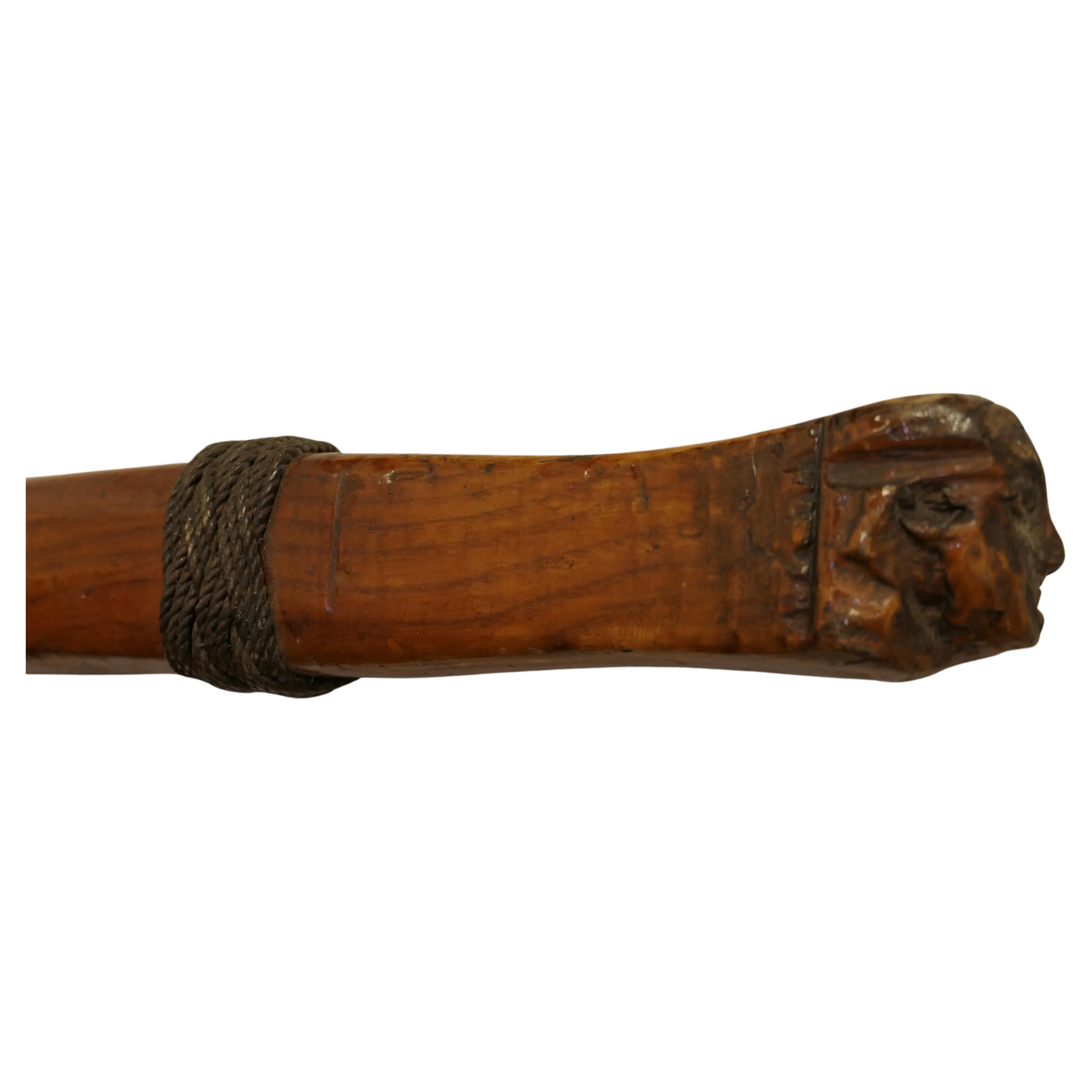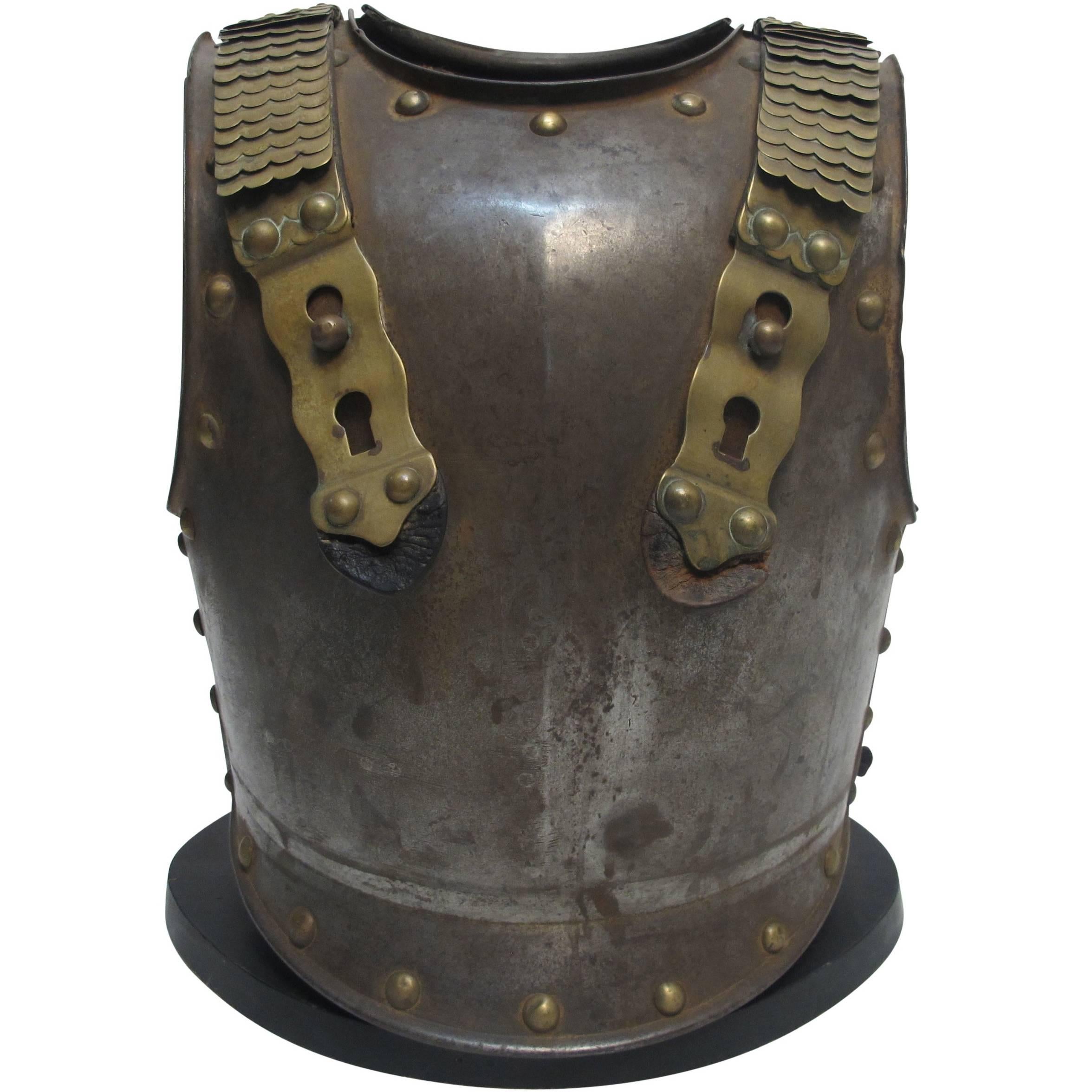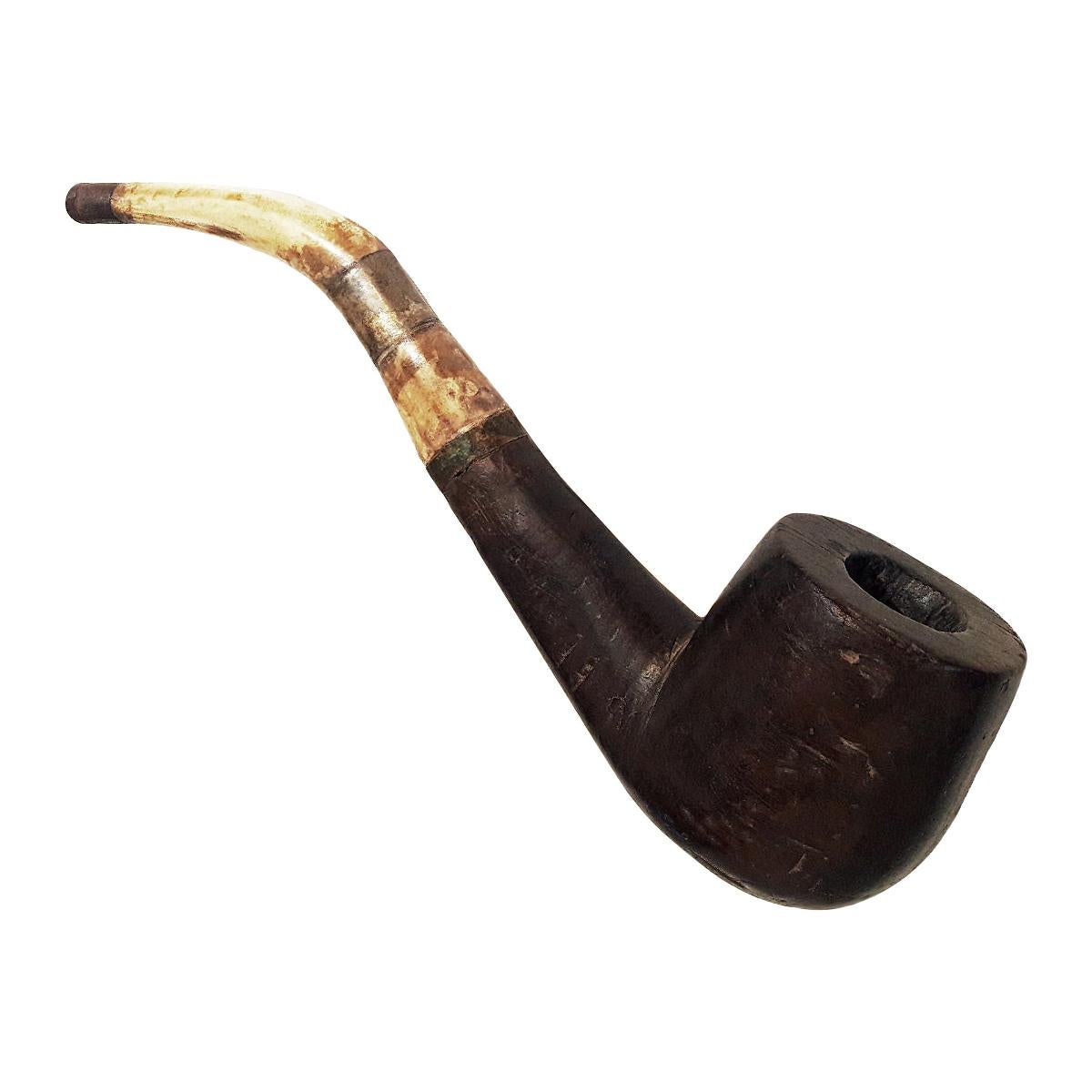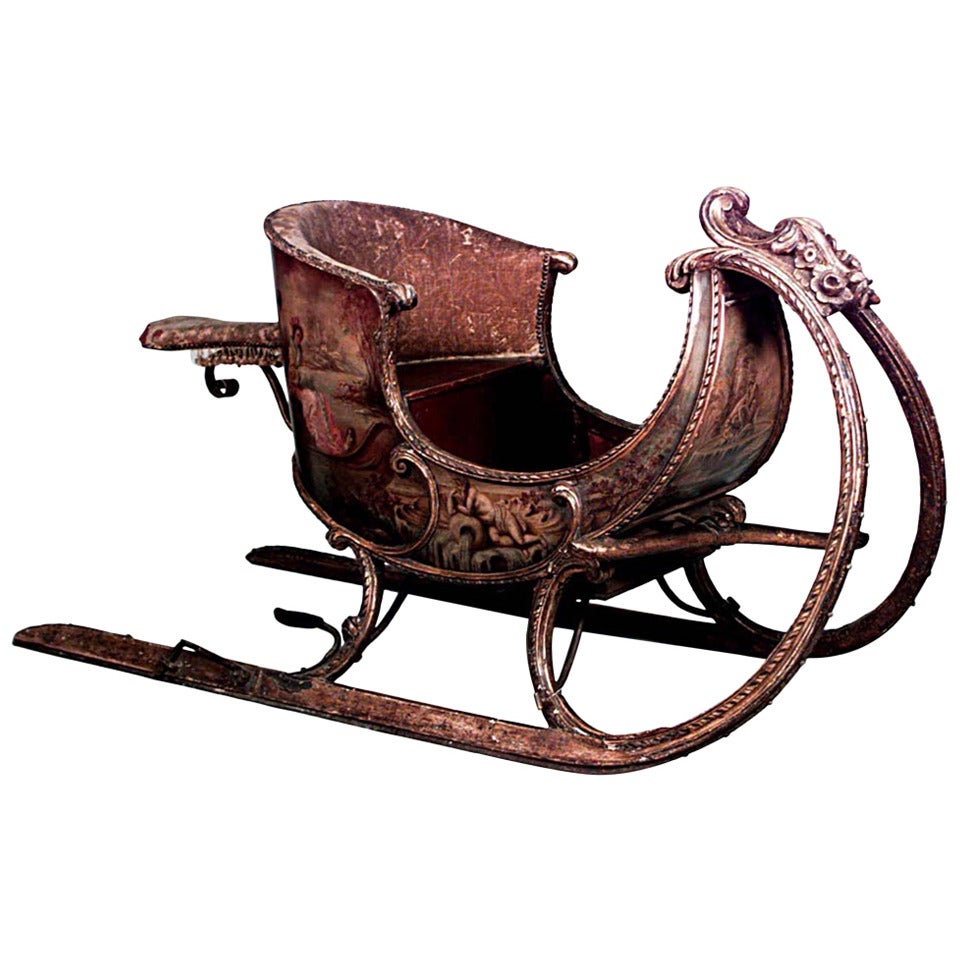Items Similar to Eastern Ship Rudder, Late 18th-Early 19th Century, Carved Wood and Brass
Want more images or videos?
Request additional images or videos from the seller
1 of 5
Eastern Ship Rudder, Late 18th-Early 19th Century, Carved Wood and Brass
About the Item
Eastern ship rudder, late 18th-early 19th century. Carved wood and brass.
English-influenced oriental ship rudder, made of brass and high quality carved wood. The rudder cap is worked in a round bundle, taking the shape of the head of a stylized greyhound. The greyhound is a typical motif of the English decorative arts of the time, but its essential treatment, elongated and with sinuous lines, reminds us that we are dealing with a piece of oriental invoice. In fact, the central area of the rudder appears completely carved with the figure of a dragon coiled around the mast. This mythical animal represents the changing power of nature, the Tao, in addition to the concept of yang (masculine), and is related to time as a propitiator of rain and water. It is also often used as a national symbol of China, and was in fact featured on the national flag until the end of the Qing dynasty. Here it is represented with great attention to detail, evidencing a virtuosity typical of oriental ornamental sculpture: we see each of the dragon's scales, and even the ripples of water under its body, the leaves between which it swims... The lower third of the rudder appears almost completely disorganized, showing a smooth slightly curved profile. At its end it is decorated with a simple recessed carving, with a geometric motif on two planes."
Size: 10 x 10 x 160 cms. Weight is orientative.
- Dimensions:Height: 63 in (160 cm)Width: 3.94 in (10 cm)Depth: 3.94 in (10 cm)
- Style:Other (Of the Period)
- Materials and Techniques:
- Place of Origin:
- Period:
- Date of Manufacture:18th-19th Century
- Condition:Wear consistent with age and use. Minor losses. Minor fading.
- Seller Location:Madrid, ES
- Reference Number:
About the Seller
4.9
Vetted Seller
These experienced sellers undergo a comprehensive evaluation by our team of in-house experts.
Established in 1985
1stDibs seller since 2017
292 sales on 1stDibs
Typical response time: 1 to 2 days
- ShippingRetrieving quote...Ships From: Madrid, Spain
- Return PolicyThis item cannot be returned.
More From This SellerView All
- Pair of Children, Polychromed Pine Wood, Spain, 18th Century and LaterLocated in Madrid, ESCouple of children. Polychrome pine wood, Century XVIII. Pair of polychrome pine wood carvings that represent two children in an attitude of playing a musical wind instrument, both seated, with their hands towards their faces, and slightly raising one leg to add some movement to a posture that, otherwise, it would be perhaps too static. Due to their postures and attitudes, they would be part of a large and quality altarpiece, judging by the size, the details, the hair, the proportions, etc., elements in which the musical angels were not something strange. Note that those present do not have wings, calling themselves in these cases "putti" and being, in the same way, figures of habitual presence in religious environments despite having emerged from Renaissance classicism and its sources from Antiquity. The proportions of the sizes, the anatomy, the symmetry, the certain plasticism of the hair, etc. are elements that speak of an influence of Neoclassicism in these sculptures. Likewise, a certain resemblance to works from the 18th century of the Castilian school can be appreciated." Size: 22 x 42 x 85 cms / c/peanas 37 x 37 x 180 cm. Weight is merely orientative. Bases and wooden instruments...Category
Antique 18th Century Spanish Neoclassical Figurative Sculptures
MaterialsOther
- Frame, Wood, Late 17th-Early 18th CenturyLocated in Madrid, ESFramework. Carved wood, late 17th-early 18th century. Rectangular frame that presents a "base structure" of straight lines, combining moldings of different widths and finishes (inside, a golden band with Fine plant details towards the corners; then a thin red one, and a wider green one, these two the latter imitating marble; outside, another fine gilt molding), enhanced with a series of carvings of vegetal elements in the corners (symmetrical composition), two ovoid elements on the long sides and a highly elaborate cresting with vegetal elements, rockeries, scrolls, flowers and imitation of fabrics (which are joined with those ovoid elements mentioned). The combination of red, green and gold is common in certain types of frames (compare, for example, with the terracotta of Salamanca made around the middle of the 16th century by Juan de Juni, which is kept in the Victoria and Albert Museum). On it, a series of carvings with a lot of movement and depth have been added, showing Baroque influence (reminiscent in certain details of works such as the frame of the Immaculate Conception by Alonso Cano...Category
Antique Early 18th Century European Rococo Picture Frames
MaterialsWood
- Mirror with angel heads. Carved and polychrome pine wood. Spanish school, 18th cLocated in Madrid, ESMirror with angel heads. Carved and polychrome pine wood. Spanish school, 18th century. Rectangular panel of carved, polychrome and gilded pinto wood that presents two ovals framed ...Category
Antique 18th Century Spanish Neoclassical Wall Mirrors
MaterialsOther
- Christ of Burgos. Wood, metal. Spanish school, 19th century.Located in Madrid, ESChrist of Burgos. Wood, metal. Spanish school, 19th century. A rectangular base serves as the base for a Latin cross with finials at the three upper ends. This has the usual “INRI” ...Category
Antique 19th Century Spanish Other Religious Items
MaterialsMetal
- Angel, Carved and Polychrome Wood, 16th CenturyLocated in Madrid, ESAngel. Carved and polychrome wood. Century XVI. Polychrome wood carving showing an angel, with the face facing the viewer and the body in pr...Category
Antique 16th Century Spanish Renaissance Figurative Sculptures
MaterialsWood
- Niche. Carved and polychrome wood. 16th centuryLocated in Madrid, ESNiche. Carved and polychrome wood. Century XVI. Wall niche with a rectangular front opening topped by a venerated shape finished in gold with two polychrome angel heads in the corne...Category
Antique 16th Century European Renaissance Religious Items
MaterialsOther
You May Also Like
- Late 18th/ Early 19th Century Wood Statue of a BishopLocated in Newport Beach, CAAntique, hand-carved and gilded statue of Bishop with original paint.Category
Antique 19th Century Italian Religious Items
MaterialsGold
- 19th Century Yacht Rudder and Carved TillerLocated in Chillerton, Isle of Wight19th Century Yacht Rudder and Carved Tiller The rudder is a good decorative piece as is the tiller which has a figure head carved on the end wit...Category
Antique Late 19th Century Folk Art Nautical Objects
MaterialsAsh
- French Military Steel and Brass Armor, Late 18th-Early 19th CenturyLocated in San Francisco, CAFrench military steel and brass breast plate body armor, having a genuine muscat ball dent, France, late 18th-early 19th century.Category
Antique Early 19th Century French Arms, Armor and Weapons
MaterialsBrass, Steel
- Burmese Wood, Bone and Brass Tobacco Pipe, Late 19th CenturyLocated in New York, NYA large tobacco pipe from old Burma (Myanmar), circa 1850. Solid wood bowl, chamber and shank. The stem is made of bone, attached to the shank by a mortise in solid brass, and a lip ...Category
Antique 1850s Burmese Other Tobacco Accessories
MaterialsBrass
- Late 18th or Early 19th c. Russian Painted SleighLocated in New York, NYLate eighteenth or early nineteenth century carved two person sleigh painted with traditional landscapes and scenes of courtly love.Category
Antique 18th Century and Earlier Russian Sports Equipment and Memorabilia
MaterialsWood, Paint
- 19th Century Carved and Painted Ship's BilletheadLocated in Nantucket, MA19th Century Carved and Painted Ship's Billethead, second half 19th Century, a scroll carved and painted wooden ornament from the bow of a ship. A billethead was a smaller carving used in place of a figurehead, mounted under the bowsprit of a ship. As the 19th Century progressed and the age of clipper ships saw a move towards ever more extreme clipper bows, there was a need to eliminate unnecessary weight aboard ship, especially in the bow (to avoid burying the nose into every wave), so billet heads...Category
Antique Late 19th Century American Federal Nautical Objects
MaterialsWood
Recently Viewed
View AllMore Ways To Browse
Ship Motif
18th Century Oriental
19th Century English Wood Carved Furniture
Wood And Brass Scale
19th Century Scale Brass
Ships With Flags
Early Brass Figure
Antique Scales And Weights
Antique Scale And Weights
Brass Dragon
18th Century Dragon
Brass Weight Scale
Nautical Decorative Objects
Dragon Scale
Chinese Wood Head
Scale Chinese Wood
Ships Mast
Brass Scale With Weights





